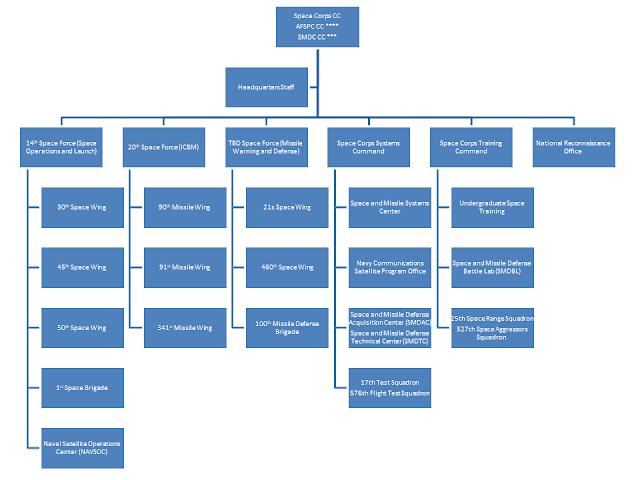"Space Force" talk peaked at the end of the last century after the Clinton Administration and Congress chartered the Commission to Assess United States National Security Space Management and Organization in 1999. The commission issued its report in January of 2001, and not much happened.
The commission proposed several suggestions, including the idea of an independent Space Corps within the Department of the Air Force. At that time, Air Force Space Command (AFSPC) included the 20th Air Force and the USAF's ICBM mission. Since that time, Air Force Global Strike Command (AFGSC) was created to manage the nuclear deterrence mission and 20th AF passed to AFGSC. AFSPC took ownership of the USAF's Cyber mission and 24th AF, but this will be passed to Air Combat Command in the near future.
The move of 24th AF is likely due in part to congressional discussions about creating a sub-unified U.S. Space Command out of U.S. Strategic Command's Joint Force Space Component.
When one looks at the history of military space functions in the various military branches over the last 40 years, one sees the following areas of military space efforts.
The U.S. Navy gave over some of its space missions to the USAF. The Navy's Space Surveillance System (the "Space Fence") moved to Air Force control in 2004 and subsequently was shuttered in 2013. The Navy managed communications satellite programs remain with the Navy, as does the Navy's role in ballistic missile defense (BMD).
The U.S. Marine Corps has no significant space mission area, and only a skeleton staff at USSTRATCOM.
The U.S. Army's primary space related role is ballistic missile defense, which is significant. The Army contains the second largest military space organization in its Space and Missile Defense Command.
What mission areas should a Space Corps encompass? Should it include the National Reconnaissance Office (NRO)? Should it include ballistic missile defense? Should it include the ICBM deterrent force? All of these are subjects for debate, but from these we can assume a reasonable maximum scope--all of the above, less the Navy's operational BMD role, host base responsibility for Kirtland Air Force Base (currently under 20th AF), and the 582d Helicopter Group (under 20th AF). The Navy's Aegis Ballistic Missile Defense System is simply a capability of the Aegis Weapon System and cannot be divided from its fleet defense role.
Who would lead such an organization? The obvious choice would be the current 4-star Air Force Space Command commander, who would become the commandant of the Space Corps. The deputy could logically be the current 3-star Army Space and Missile Defense Command commander, but promoting him or her to a 4-star grade equal to other service deputies. Of course both of these leaders would move to the Pentagon where the new service would be headquartered.
That creates the following as a potential U.S. Space Corps organization:
A period of transition would allow moving Army Space Cadre and Army Space Operations Functional Area personnel, and Air Force space and missile primary AFSC personnel, who currently are assigned outside of the prospective Space Corps units to move into the Space Corps.
Likewise, those who are serving in space and missile roles who do not maintain a space or missile primary MOS/AFSC would be given time to return to assignments associated with their primary MOS/AFSC.
A challenge for Army personnel is this connection of modern BMD personnel to historical Air Defense Artillery Branch. The 100th Missile Defense Brigade, the operational BMD unit of the Army Space and Missile Defense Command no doubt has personnel who shift between the national missile defense roles and theater Air & Missile Defense and Air Defense Artillery organizations. This is why the majority of the personnel who move to the Space Corps via inter-service transfer need to be from the Army Space Cadre. Certainly some exchange postings could be made available, more initially, fewer later, to ease the separation of theater and national missile defense roles.
The small number of uniformed Navy personnel associated with the new Space Corps should be given the option of transferring to non-Space Corps related positions on their next move, but those with space related specialties should be allowed to transfer to the Space Corps.
Finally, decisions would need to be made regarding supporting MOS/AFSC positions as to who would transfer to the Space Corps, and who would remain with their parent services. Most of these are traditional host installation support roles, such as a civil engineering and security, as well as traditional personnel and administration positions. As an independent service within the Department of the Air Force, at least initially the host installation support positions could remain with the Air Force.
The initial total end strength of the Space Corps will be 20,000 to 25,000 (depending on the level of host installation support personnel transferred), and will likely have 30-35 general officers leading the various headquarters.
Some host installation support and medical support should remain within the Air Force to minimize unnecessary duplication. Officer accession and senior officer professional military education should continue to be a part of the Air Force, while enlisted professional education and mid-grade officer professional education (Command and Staff College) should be tailored to the needs of the Space Corps. Enlisted accession could be co-located with Air Force enlisted training but operate separately.
